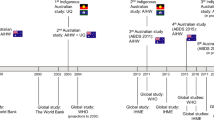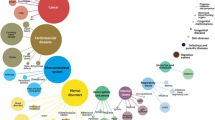Abstract
Background
Evidence-based policy measures need non-interest-guided information about the health status of a population and the diseases that affect the population the most. In such cases, a national burden of disease study can provide reliable insights at the regional level.
Aim
This article presents the potential of the BURDEN 2020 project and its expected outcome for Germany at the national and regional level.
Methods
The BURDEN 2020 project uses several indicators including years of life lost (YLL) to cover the impact of mortality and years lived with disability (YLD) to cover morbidity. The sum of both is the measure of population health called disability adjusted life years (DALY).
Results
The study ranks individual diseases and risk factors based on their impact on population health. The burden of disease approach is assumed to be sensitive to subnational differences and may generate immediate benefits for regional planning. The BURDEN 2020 study will pilot a national burden of disease study for Germany that will later be transformed into a continuous data processing and visualization tool. This is done by using, modifying and supplementing the methodology employed by the Global Burden of Disease (GBD) study to better fit the needs of health policy in Germany. This study is aimed at calculating the disease burden for up to 17 preselected diseases. Furthermore, the estimates of burden of disease are attributed to a selected set of risk factors.
Conclusion
The Burden 2020 study will provide the results of a new, health-related data processing system to the public. This includes a noninterest-guided presentation of the burden of disease (DALY) in Germany at the national and regional level.
Zusammenfassung
Hintergrund
Evidenzbasierte Politikmaßnahmen benötigen unabhängige Informationen über den Gesundheitszustand einer Bevölkerung und die Erkrankungen, von denen die Bevölkerung am meisten betroffen ist. Hier kann eine nationale Krankheitslaststudie zu verlässlichen Erkenntnissen auf regionaler Ebene beitragen.
Ziel
Dieser Artikel beschreibt das Potenzial des Projekts BURDEN 2020 und seine erwarteten Ergebnisse für Deutschland auf nationaler und regionaler Ebene.
Methoden
BURDEN 2020 verwendet mehrere Indikatoren, darunter „years of life lost“ (YLLs, durch vorzeitigen Tod verlorene Lebensjahre), um die Auswirkungen der Mortalität zu erfassen und „years lived with disability“ (YLDs, mit Krankheit/Behinderung verbrachte Lebensjahre) um die Morbidität abzubilden. Die Summe beider Indikatoren gibt Aufschluss über die Gesundheit der Bevölkerung („disability-adjusted life years“, DALYs).
Ergebnisse
Die Studie ordnet einzelne Krankheiten und Risikofaktoren nach ihrem Einfluss auf die Gesundheit der Bevölkerung. Die Krankheitslast unterliegt regionalen Unterschieden und kann unmittelbare Vorteile für die Planung leisten. BURDEN 2020 pilotiert eine nationale Krankheitslaststudie für Deutschland, die später in ein kontinuierliches Datenverarbeitungs- und Visualisierungstool überführt werden soll. Dazu wird die Methodik der Global-Burden-of-Disease-Studie genutzt und modifiziert, um den Bedürfnissen der Gesundheitspolitik in Deutschland besser gerecht zu werden. Ziel ist, die Krankheitslast für bis zu 17 ausgewählte Krankheiten zu berechnen. Den Schätzungen der Krankheitslast werden ausgewählte Risikofaktoren zugeordnet.
Schlussfolgerung
Burden 2020 wird die Ergebnisse eines neuen, gesundheitsbezogenen Datenverarbeitungssystems der Öffentlichkeit zur Verfügung stellen. Dazu gehört eine interessenunabhängige Darstellung der Krankheitslast in Deutschland auf nationaler und regionaler Ebene.






Similar content being viewed by others
Change history
13 August 2018
Erratum to:
Bundesgesundheitsbl (2018)
https://doi.org/10.1007/s00103-018-2793-0
The original publication of this article contained an error in the list of the authors, in which the contributing author Christian Schmidt was missing. The full list of authors has now been updated. The original article …
References
Murray CJL, Lopez AD (1996) The global burden of disease: a comprehensive assessment of mortality and disability from diseases, injuries, and risk factors in 1990 and projected to 2020. Harvard School of Public Health, Cambridge (on behalf of the World Health Organization and the World Bank)
Murray CJL, Vos T, Lozano R et al (2012) Disability-adjusted life years (DALYs) for 291 diseases and injuries in 21 regions, 1990–2010: a systematic analysis for the Global Burden of Disease Study 2010. Lancet 380:2197–2223
Murray CJL, Ezzati M, Flaxman AD et al (2012) GBD 2010: design, definitions, and metrics. Lancet 380:2063–2066
Murray CJL, Ezzati M, Flaxman AD et al (2012) GBD 2010: a multi-investigator collaboration for global comparative descriptive epidemiology. Lancet 380:2055–2058
GBD 2016 Dalys and Hale Collaborators, Hay SI, Abajobir AA et al (2017) Global, regional, and national disability-adjusted life-years (DALYs) for 333 diseases and injuries and healthy life expectancy (HALE) for 195 countries and territories, 1990–2016: a systematic analysis for the Global Burden of Disease Study 2016. Lancet 390:1260–1344
Institute for Health Metrics and Evaluation (IHME) (2017) GBD Compare. Seattle, WA: IHME, University of Washington. http://vizhub.healthdata.org/gbd-compare. Accessed 04.07.2018
Gesundheitsberichterstattung des Bundes (2018) Sterbefälle, Sterbeziffern je 100.000 Einwohner (altersstandardisiert) (ab 1980). Gliederungsmerkmale: Jahre, Region, Alter, Geschlecht, Nationalität, Todesursachen laut “Europäischer Kurzliste”, Art der Standardisierung. http://www.gbe-bund.de. Accessed: 04.07.2018
Jacobs E, Hoyer A, Brinks R, Kuss O, Rathmann W (2017) Burden of mortality attributable to diagnosed diabetes: a nationwide analysis based on claims data from 65 million people in Germany. Diabetes Care 40:1703–1709
Röckl S, Brinks R, Baumert J et al (2017) All-cause mortality in adults with and without type 2 diabetes: findings from the national health monitoring in Germany. BMJ Open Diabetes Res Care 5:e451
Atlas Group (2015) Update of mortality attributable to diabetes for the IDF Diabetes Atlas: estimates for the year 2013. Diabetes Res Clin Pract 109:461–465
Knudsen A, Tollånes M, Haaland Ø, Kinge J, Skirbekk V, Vollset S (2017) Disease burden in Norway 2015. Results from the Global Burden of Diseases, Injuries, and Risk Factors Study 2015 (GBD 2015). Folkehelseinstituttet, Bergen (in Norwegian)
Newton JN, Briggs AD, Murray CJ et al (2015) Changes in health in England, with analysis by English regions and areas of deprivation, 1990–2013: a systematic analysis for the Global Burden of Disease Study 2013. Lancet 386:2257–2274
Steel N, Ford J, Newton J et al (2018) Global burden of disease (GBD) 2016 subnational estimates for 150 English local authorities. Abstract: European Public Health Association. Ljubljana Nov 2018
Scotpho (2017) The Scottish Burden of Disease Study, 2015 overview report. NHS Scotland, Edinburgh
National Institute for Public Health and the Environment (RIVM) (2014) A healthier Netherlands: key findings from the Dutch 2014 Public Health Status and Foresight Report. RIVM, Bilthoven
Devleesschauwer B, Maertens De Noordhout C, Smit GS et al (2014) Quantifying burden of disease to support public health policy in Belgium: opportunities and constraints. BMC Public Health 14:1196
National Institute for Public Health and the Environment (RIVM), Ministry of Health Welfare and Sport (2018) The Public Health Foresight Report, The Netherlands
Scheidt-Nave C, Ziese T, Fuchs J et al (2016) Proceedings of the international workshop “From global burden of disease studies to national burden of disease surveillance”. BMC Proc 10:5
Diederichs C, Neuhauser H, Kroll L et al (2017) Regionale Unterschiede in der Prävalenz von kardiovaskulären Risikofaktoren bei Männern und Frauen in Deutschland. Bundesgesundheitsbl 2
Dornquast C, Kroll LE, Neuhauser HK, Willich SN, Reinhold T, Busch MA (2016) Regionale Unterschiede in der Prävalenz kardiovaskulärer Erkrankungen. Dtsch Arztebl Int 113:704–711
Erhart M, Von Stillfried D (2012) Prävalenz depressiver Störungen auf Basis vertragsärztlicher Abrechnungsdaten 2007. Versorgungsatlas 12/06. Zi, Berlin
Goffrier B, Schulz M, Bätzing-Feigenbaum J (2017) Administrative Prävalenzen und Inzidenzen des Diabetes mellitus von 2009 bis 2015. Versorgungsatlas 17/03. Zi, Berlin
Hollederer A (2013) Adipositas in Nordrhein-Westfalen und dessen Kommunen im Mikrozensus 2009: Prävalenz, Krankenstand und Präventionspotenziale. Deut Med Wochenschr 138(06):253–259
Stein C, Newton J (2017) Sharing the burden: a new European Burden of Disease Network is formed. Eur J Public Health 27:191–192
Swart E, Ihle P, Gothe H, Matusiewicz D (eds) (2014) Routinedaten im Gesundheitswesen. Huber, Bern
Heidemann C, Scheidt-Nave C (2017) Prevalence, incidence and mortality of diabetes mellitus in adults in Germany – A review in the framework of the Diabetes Surveillance. J Health Monit. https://doi.org/10.17886/RKI-GBE-2017-062
Scheidt-Nave C, Kamtsiuris P, Gößwald A et al (2012) German health interview and examination survey for adults (DEGS)—design, objectives and implementation of the first data collection wave. BMC Public Health 12:730–730
Robert Koch-Institut (ed) (2016) Cancer in Germany 2011/2012, 10th edn. Robert Koch Institute, Association of Population-based Cancer Registries in Germany, Berlin
Kroll LE, Schumann M, Müters S, Lampert T (2017) Möglichkeiten der Regionalisierung von Gesundheitsindikatoren mit Small-Area-Estimation. Bundesgesundheitsblatt Gesundheitsforschung Gesundheitsschutz 60:1429–1439
Kroll LE, Schumann M, Hoebel J, Lampert T (2017) Regional health differences – developing a socioeconomic deprivation index for Germany. In: Robert Koch-Institut, Epidemiologie und Gesundheitsberichterstattung. https://doi.org/10.17886/RKI-GBE-2017-035
Zeiher J, Kuntz B, Lange C (2017) Smoking among adults in Germany. In: Robert Koch-Institut, Epidemiologie und Gesundheitsberichterstattung. https://doi.org/10.17886/RKI-GBE-2017-043
Acknowledgements
The authors thank Alexander Kröhnke, Martin Thißen and Kerstin Möllerke for their help in creating the illustrations. Thanks to Simon Phillips and Tim Jack for proofreading the article.
Author information
Authors and Affiliations
Corresponding author
Ethics declarations
Conflict of interest
A. Rommel, E. von der Lippe, D. Plaß, A. Wengler, A. Anton, C. Schmidt, K. Schüssel, G. Brückner, H. Schröder, M. Porst, J. Leddin, M. Tobollik, J. Baumert, C. Scheidt-Nave and T. Ziese declare that they have no competing interests.
This article does not contain any studies with human participants or animals performed by any of the authors.
Additional information
The original version of this article was revised: The original publication of this article contained an error in the list of the authors, in which the contributing author Christian Schmidt was missing. The full list of authors has now been updated.
Rights and permissions
About this article
Cite this article
Rommel, A., von der Lippe, E., Plaß, D. et al. BURDEN 2020—Burden of disease in Germany at the national and regional level. Bundesgesundheitsbl 61, 1159–1166 (2018). https://doi.org/10.1007/s00103-018-2793-0
Published:
Issue Date:
DOI: https://doi.org/10.1007/s00103-018-2793-0
Keywords
- Burden of disease
- Disability adjusted life years
- Non-communicable diseases
- Health policy planning
- Regional prevalence




